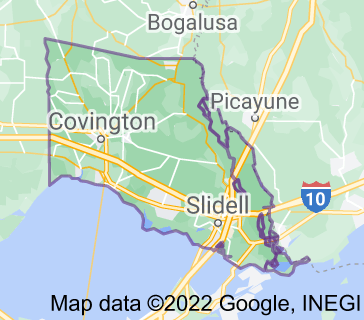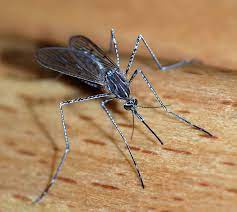
I will admit I thought long and hard on this one. It is part of the census series and I did the first one which showed that Louisiana’s population grew below I-10 and in the New Orleans area. St Tammany Parish is largely above I-10 but they are in the New Orleans area despite their being covered in the paper more out of Baton Rouge than New Orleans. That being said, they are seeing growth and it is raising the problems that growth brings.
When Robin Parker would visit family in Covington, Mandeville and Slidell as a girl in the 1960s and 1970s, much of St. Tammany Parish was the country. She fondly recalls how Highway 190 had only two lanes, lined with acres of trees. There were no Walmarts back then, and the interstate system was still being built. When she moved back to the north shore in 2005 after living out of state for decades, she lived in one of a dozen homes in the Madisonville Farms subdivision. But a few months after Hurricane Katrina, land was cleared and hundreds of new houses were built around her, filling it to capacity to support a wave of new residents. The runaway growth in western St. Tammany hasn’t stopped since. “It’s not as quiet and sleepy,” Parker said. “Sometimes I get the feeling we’re becoming what Metairie was 30 years ago.”
nola.com
Metairie 30 years ago? I would guess less than 30 having seen growth in the last place we lived. St Tammany is a suburb that does not look like one.
St. Tammany may not be the suburban archetype embodied by the rows upon rows of homes and strip malls of Jefferson Parish’s east bank, but Parker’s not far off the mark. Nearly 265,000 people now call St. Tammany their home, following decades of booming growth that has seen open fields replaced with subdivisions and shopping centers at a rate that has consistently ranked it among Louisiana’s fastest-growing parishes. The past 10 years saw St. Tammany grow by 30,800 people — more than any parish save Orleans, which was still rebuilding from Hurricane Katrina. That amounts to a 13% increase over the last census, the fourth-highest growth rate in the state. That jump, which far outpaced Louisiana’s 3% increase as a whole, actually represents a slackening of the explosive growth St. Tammany has seen since the 1970s. Each of the last four decades had seen the population jump by a third or more. Exurbs like western St. Tammany — once-rural areas morphing into populous suburbs — have been among the fastest-growing areas in the U.S. in recent decades, a trend that slowed only once, during the Great Recession, when people began to flock back to cities, according to a Brookings Institute report.
Uniformity is not what the growth shows. Go farther north there is a lot of open land. Try to find it in Covington.
Of course, a drive around many of the still sparsely populated areas in the north of the parish will quickly show that Tammany’s growth is far from uniform. It remains concentrated around the historic population centers of Mandeville, Slidell and Covington. Growing up in Metairie, Jamie Segura often took trips to the north shore for its rural pleasures – to “come to the country, to swim in the rivers.” In the early 1990s, experts predicted the parish would fill out between Madisonville and Slidell, so when she moved back to Louisiana for a job after college in the early 1990s she built a house in a small subdivision in Madisonville, then a quaint town, hoping to retain her peaceful existence as St. Tammany grew. But the predictions proved incorrect. During the last decade, no part of the parish grew faster than the area around Madisonville, a small town just west of Mandeville, where the Tchefuncte River empties into Lake Pontchartrain. In just two decades, the population of the Madisonville area has skyrocketed by 540%, jumping from 1,765 people in 2000 to 11,328. “Everybody wants to move here and have a nice, quiet country life,” said Segura, who left Madisonville and now lives in an apartment in Covington. “But we don’t really have that anymore.”
The first article said that people moved to be within a levee system and this is an area where more levees are to be build or strengthened.
More broadly, the entire area west of Covington and running from Lake Pontchartrain to La. 1078 has seen incredible growth. Just shy of 8,300 residents in 2000, it now counts about 35,400 people. The increase there accounts for about a third of the parish’s population gain since 2000; most of the growth came in the last decade. While the vast majority of residents — nearly 89% — in that area of western St. Tammany are White, according to census data, St. Tammany as a whole is more diverse than ever before. Though the parish was 85% White in 2000, that proportion has fallen to less than 73%. For the most part, that was due to changes around Slidell, where over the last two decades the White population has shrunk and the Black population has more than doubled — from 9,180 in 2000 to 20,556 last year. The once-tiny Hispanic community grew dramatically. The result: The non-White share of the population around Slidell shot up from about 20% to about 40%.
There has always been a movement to the North Shore by people from New Orleans as they sought a better, quieter life with better schools. And yes, there is a code word in there.
The population boom in the parish’s western flank is the latest iteration of a steady shift to the north shore, spurred first by White flight after schools were integrated in New Orleans and later job opportunities at the John C. Stennis Space Center in nearby Mississippi. Later, the north shore received a large influx of residents fleeing hard-hit areas after Hurricane Katrina. When a newcomer to Madisonville in the 1980s complained about a rooster disturbing the peace, the town sided with the bird, in a memorable controversy. But two years ago, the council considered passing a ban on all chickens. A lot has changed. Madisonville is a quaint and small, barely meeting the threshold for incorporation. But its outskirts have mushroomed over the last few decades: Subdivisions named after creeks and trees now line La. 22, where traffic is often at a standstill during rush hours. The population increases have exposed the rickety infrastructure, said Mike Lorino, the chairman of the St. Tammany Parish Council, whose district includes the area. Madisonville is “bursting at its seams,” he said. “It’s just an explosion of people moving across the bridge for the quality of life,” Lorino said. “But the main issue we have is the traffic. The people are already here and we’re trying to rectify the problem.”
Traffic is a part of life in the suburbs as so many times the houses are built and feed into inadequate roads for the volume increase.
At its worst, La. 22 backs up for miles from Madisonville, sometimes all the way to West Causeway Approach, four miles away. Some residents vent their traffic frustrations in Facebook groups like “Madisonville’s Stupid Bridge” and “West St. Tammany Traffic,” dedicated to warning commuters about bridge malfunctions and congestion. Lorino is hopeful that proposed infrastructure projects may offer relief soon – roundabouts at several problem spots, widening Interstate 12. But some have pushed for bigger ideas, like adding a high school in Madisonville and building a bypass off the Causeway. Two locals have proposed a privately funded toll bridge over the Tchefuncte River, but officials have been cool to the idea. In 2017, Lorino imposed a moratorium on new development in his district until infrastructure is addressed. But more housing has cropped up over parish lines in Tangipahoa.
Growth is not just people moving in from far destinations, hurricanes have an effect on people moving to safer spots, the levee concept.
Lesli Fumar, a real-estate agent and 20-year north shore resident, said most newcomers want to live on the west side of the parish. Recently, people who lost their homes in Hurricane Ida from St. Charles Parish or LaPlace have been migrating here. Though houses get snapped up as soon as they go on the market in most cases, she said the solution should not come in the form of more subdivisions, particularly developments on wetlands that contribute to drainage issues and cause flooding in new areas. “They’re trading trees for profit,” she said. “People come here looking for a certain life – country life close to amenities — but we don’t have the infrastructure to handle everyone.”
Some do move farther out but this involves trade offs.
Parker, who still lives in Madisonville, said some people she knows have moved to farther-flung areas in the parish, like Sun or Folsom, to escape the heavy traffic. But there’s a tradeoff: losing easy access to amenities that have grown with the population. So for now, she’ll stay in her subdivision. “There’s nowhere else for me to go, nowhere I’d rather be,” she said. “I’m just going to grin and bear it.”
We see this growth when we drive to the North Shore or across the Bridge to the West Bank. People have moved there and traffic grows with the move. Yet, as noted, so do the amenities shopping, restaurants and such.



